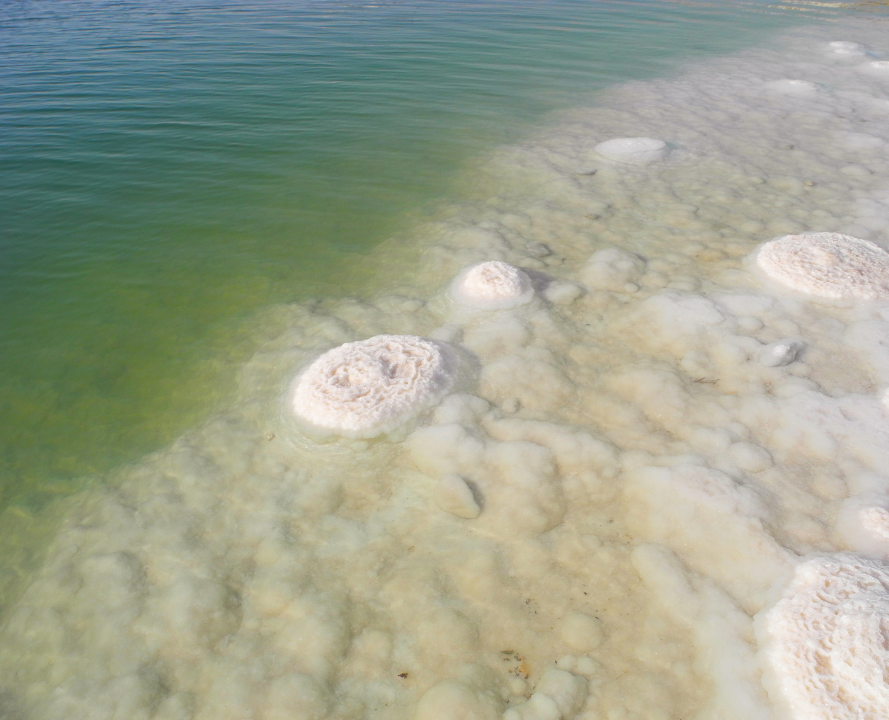
The Dead Sea in Israel is a landlocked salt lake which is the saltiest and deepest lake in the world. It is also of the lowest elevation and has the greatest concentration of minerals than any ocean (a concentration of 32% minerals compared to other seas, holding approximately 3%).
Queen Cleopatra went to great lengths to secure exclusive reign over the Dead Sea; she attributed her great beauty and complexion to the secrets of the sea and its salts.
Dead Sea Salt is not used in cooking as the high concentration of minerals makes it too bitter to flavour food.
Bromides and Iodine are present in Dead Sea Salt, including other minerals in a dried form, such as Magnesium, Sodium, Calcium and Potassium. All these minerals work together as regulators of cell activity and daily functioning, relieving muscular pain and stabilizing fluid levels in the body.
Magnesium – is great for detoxifying and cleansing the epidermis. It promotes the cell metabolism, and in turn helps heal damaged or inflamed skin.
Calcium – promotes skin growth and regeneration, moisture retention through the production of sebum, and stimulates the production of antioxidants.
Sodium – helps cleanse and exfoliate the skin, neutralise free radicals which can degenerate skin cells, and relieve sore muscles.
Zinc – also helps heal and rejuvenate skin, ward off acne, and protects the skin’s lipids and fibroblasts cells that create collagen.
Potassium – is great for keeping skin moist and plump, and for reducing puffiness.
Sulphur – Sulphur helps decongest pores. It also has powerful healing, antifungal, antimicrobial, and antibacterial properties.
The National Psoriasis Foundation recommends Dead Sea and Dead Sea salts as effective treatments for psoriasis. High concentration of magnesium in Dead Sea salt may be helpful in improving skin hydration and reducing inflammation, although Epsom salt is a much less expensive salt that also contains high amounts of magnesium and therefore may be equally as useful for this purpose.
References:
www.newdirections.com.au. (n.d.). 1 kg Bath Salt Dead Sea Mineral. [online] Available at: https://www.newdirections.com.au/epages/newdirections.sf/en_AU/?ObjectID=55191 [Accessed 7 Nov. 2022].
DeadSea.com. (2018). 5 Ways to Use Dead Sea Salt: What’s Dead Sea Salt Good For? [online] Available at: https://deadsea.com/articles-tips/dead-sea-salt-for-your-skin-and-in-your-kitchen/#:~:text=So%20what%20is%20so%20special [Accessed 7 Nov. 2022].
Contributors to Wikimedia projects (2008). salt extracted from the Dead Sea. [online] Wikipedia.org. Available at: https://en.m.wikipedia.org/wiki/Dead_Sea_salt [Accessed 7 Nov. 2022].
WebMD. (n.d.). Health Benefits of Dead Sea Salt. [online] Available at: https://www.webmd.com/skin-problems-and-treatments/health-benefits-dead-sea-salt [Accessed 16 Nov. 2022].
Pletcher, K. (2019). Dead Sea | History & Facts. In: Encyclopædia Britannica. [online] Available at: https://www.britannica.com/place/Dead-Sea [Accessed 17 Nov. 2022]
The Salt Box. (n.d.). Dead Sea Salt: The Ultimate Guide to Uses, Origins, Benefits. [online] Available at: https://www.thesaltbox.com.au/news/dead-sea-salt-the-ultimate-guide-to-uses-origins-benefits/?gclid=Cj0KCQiAsdKbBhDHARIsANJ6-jdseYbPAxo4NQlEIhXxL9fYf0g9tf_JYf4JmqMt4kkMI-IslQhMOYoaAkf9EALw_wcB [Accessed 16 Nov. 2022].
Healthline. (2019). Benefits of a Sea Salt Bath: Types, Best Practices, Precautions. [online] Available at: https://www.healthline.com/health/sea-salt-bath [Accessed 16 Nov. 2022
